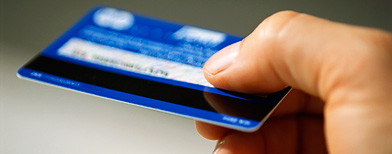 Will your credit card become unreadable if it’s exposed to magnets? In a previous story, we said yes, but many of you begged to differ. Seeing that, we took the challenge of clearing things up once and for all.
Will your credit card become unreadable if it’s exposed to magnets? In a previous story, we said yes, but many of you begged to differ. Seeing that, we took the challenge of clearing things up once and for all.
The result: With the help of a junkyard magnet, a garden–variety refrigerator magnet and a professor with a vast knowledge of magnetics, we were proved right –– eventually.
A highly charged debate ensued after our “How to destroy a credit card” was published in September of 2009. Folks started weighing in on whether magnets –– especially those of the refrigerator persuasion –– actually had the power to strip a stripe. “Running a magnet across the strip will do nothing,” said one commenter on our video at YouTube.com. Others chimed in with their own experiences with credit cards and magnets.
So we put our cards to the test against a barrage of different magnets, even heading to the junkyard to swipe stripes with some serious electromagnetic forces.
But before we get to the results, let’s take a step back.
The Mystery of the Stripe
Credit card magnetic stripes carry more than just your precious financial data; they carry some mystery, too.
The stripe you see on the back of your card is a collection of magnetic particles –– each a very small magnet about 20 millionths of an inch long. It’s a commonly held belief that exposure of these particles to an external magnet can scramble the information and make the card unreadable.
That’s the theory. But does it really happen? We sought to find out.
Magnets on a Mission
Our experiment began with three different magnets of various strengths:
• A generic refrigerator magnet, similar to the one that’s probably holding up your kid’s artwork in your kitchen.
• A slightly more powerful magnet, which is capable of holding up to 72 pounds.
• A junkyard magnet, which can hold about 7,000 pounds and is also just plain fun to watch in action.
You never know when you’ll just happen to be waving your credit card around in a junkyard.
We swiped three separate cards –– all were tested and functioning properly before the experiment, by the way –– with one of these types of magnets; then took them to a local retailer who ran each card through a credit card machine to test which ones were still readable and which ones weren’t.
Once all preparations were in place, it was time for the big reveal.
Moment of Truth
Up first was the card exposed to the fridge magnet. It turned out that it was still readable by a credit card machine. The second, larger magnet was not, despite multiple swipes. Could we have been on the way to the major scientific breakthrough we’d been hoping for?
Not so fast. It was time to put the third card, the one exposed to the junkyard magnet, to the test –– and surprisingly, the card was still readable. It had survived the most powerful magnet in our arsenal.
This caused considerable confusion. Our initial assumption was that the strength of the magnet would play a role in the demagnetization process. Thus, a wimpy refrigerator magnet wouldn’t have the data–destruction powers of a gigantic junkyard magnet.
We were wrong.
Puzzled, we turned to an expert for answers.
Calling In the Expert
Totally stumped by the fact that just one out of three magnets (the one of medium strength) had rendered a card unreadable, we sought out the guidance of A. Dean Sherry, a chemistry professor at the University of Texas at Dallas.
Sherry is also associate director of the Rogers Nuclear Magnetic Resonance Center and a radiology professor at the university’s Southwestern Medical Center. In other words, he’s got plenty of magnetic experience for our purposes.
He heard us out and politely corrected our assumption about the relationship between the strength of the magnet and its power over the data on the stripe. “The field strength isn’t all that important,” he said. “Even the refrigerator magnet should work eventually.”
So what was the deciding factor? Exposure time.
“It is well known that magnets will wipe out information on credit card stripes,” Sherry said. “However, it doesn’t always happen after one exposure. It may take several exposures for the card to be deactivated, but it will happen eventually.”
Huh. So armed with that information, we decided to replicate the experiment with the refrigerator magnet. We left the magnet exposed to the credit card stripe for several minutes and took a few more swipes for good measure.
Then we took it back to the store and … success. The card’s stripe had been demagnetized.
Not the Only Way to Destroy a Card
The safest, most practical way to destroy your credit card, however, is to cut it into tiny pieces using a shredder or a pair of scissors.
For an extra level of protection (or if you just want to replicate our very cool experiment), you can use a magnet on the stripe. Just be sure to expose it for a significant amount of time –– that goes for heavy–duty junkyard magnets, too.
Did you know that if you subscribe to our website, you will receive email notifications whenever content changes or new content is added.
1. Enter your e-mail address below and click the Sign Me Up button.
2. You will receive an email asking you to confirm your intention of subscribing to our site.
3. Click the link in the email to confirm. That’s all there is to it! Note: if you wish to unsubscribe from our site, click the unsubscribe link at the bottom of the email you received.
Then indicate you no longer wish to receive our emails.
Thank You
Prisonbreakfreak.com Team